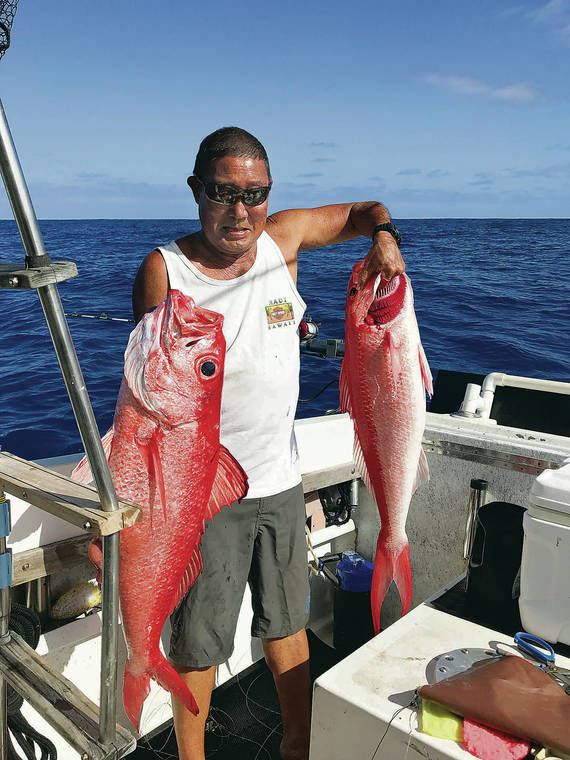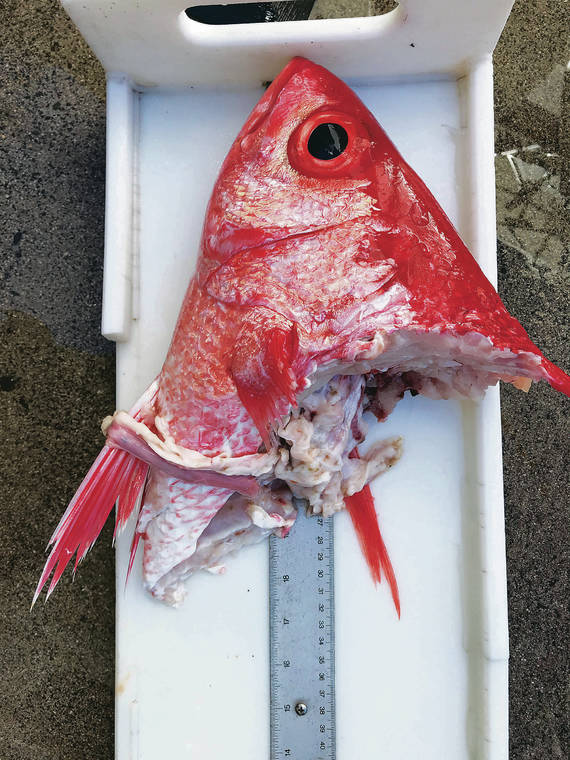Something’s in the water and it’s got fishers worried.
Hawaii’s bottomfish catch is way down for some, and sharks may be the culprit.
Commercial bottomfish fishers who go after the valuable “Deep 7” — lehi, ehu, onaga, opakapaka, kalekale, gindai and hapuupuu — caught just under 180,000 pounds of those species in the 2018-2019 season.
That’s more than 50,000 pounds less than what was reported in each of the 2017-2018 and 2016-2017 seasons, representing a roughly 25% drop in catch.
The 2018-2019 season, which started Sept. 1, 2018, and ended Aug. 31, was the worst since 1973, according to data from the National Oceanic and Atmospheric Administration that dates back to 1949.
The fishery averaged about 240,000 pounds annually over the last decade before last year’s anomaly, but that’s still just a sliver of about 35 million pounds of fish that commercial fishers in Hawaii report every year.
Bottomfishing is not a major industry. Longline fishing brings in the biggest catch, accounting for about 30 million pounds per year; tuna handling nets around 1 million pounds annually; and trolling brings in more than 2 million.
But the drop in the bottomfish catch last season has those fishers worried and some suspect that depredation — when hooked fish get eaten — played a significant role.
Roy Morioka, a commercial bottomfish fisher, blames shark depredation for the unusually slow year. He said up to 50% of his hooked catch was taken by sharks, much higher than the 10% or so he said is usually taken.
“It happens every year, but not to the extent of 40-50% of our catch,” he said.
Though sharks are not the only animals that take hooked fish, Morioka said he knows sharks are responsible because he “can see the sucker come all the way up to the surface.”
Morioka has been bottom fishing for 60 years and said this is the first time he’s considered stopping.
“Amongst the fishermen, everyone’s saying there’s more sharks,” said Edwin Watamura, who is also a bottomfish fisher. “It’s hard to get a fisherman not saying that he’s noticing more sharks.”
Morioka attributed the increased shark presence to El Nino, which brings warmer waters to Hawaii, and sharks along with it. He said that although El Nino has ended, the warm water associated with it has persisted.
Some commercial fishing data confirms fishers’ observations while others don’t, possibly shedding light on the inconsistencies surrounding fishers’ catch reports.
While the low fishing catch reports from NOAA support claims of increased depredation, its actual depredation numbers showed the opposite.
For the season, fewer than 1,400 instances of depredation were reported by bottomfish fishers, the lowest since depredation reporting started in 2002. In about half the years since, fishers have reported more than 2,000 instances of depredation, and in one year nearly 3,800.
All commercial fishers are required to submit monthly reports of their catches to the State Department of Land and Natural Resources, and for Deep 7 species that are landed, lost to depredation or released, a report is required five days after the fishing trip is completed.
Kim Holland, a shark researcher at the University of Hawaii’s Institute of Marine Biology, said that shark depredation is and has been a problem for fishers, and it disproportionately affects bottomfish fishers. However, he said catch reports are inconsistent and unreliable, adding that although fishers are required to report their annual catches, they know that it’s difficult for the state Division of Aquatic Resources to enforce that rule.
“I would not put any credence in official records, just because I know for a fact that the way they were collected was not consistent and not reliable,” Holland said. “Up until about 10 years ago, all of those records … they may have not been voluntary legally, but there was no enforcement.”
Holland has previously said that the department is spread too thinly to enforce fishing-related regulations.
There isn’t any substantial incentive for fishers to provide accurate fishing catch reports, and doing so could even be detrimental to them. Morioka said one of those reasons is that catching too much might be perceived as “pillaging” fish populations.
Although the new bottomfish season started last month, its peak lasts from about November through January, so fishers will have to wait until then to know definitively whether last season’s problems were the beginning of a trend or a fluke.




